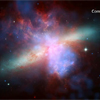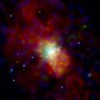CXC Home | Search | Help | Image Use Policy | Latest Images | Privacy | Accessibility | Glossary | Q&A
Tour of M82
Quicktime MPEG
When seen in visible light from the Hubble Space Telescope, M82 looks like an ordinary spiral galaxy. However, looking at it through the Spitzer Space Telescope in infrared radiation, we see a startlingly different picture with material being blasted from the galaxy's disk. X-ray data from Chandra reveal scorching gas that has been heated to millions of degrees by this violent outburst. The composite image of all of these different data reveals the true nature of this galaxy.
[Runtime: 0:35]
Quicktime MPEG
When seen in visible light from the Hubble Space Telescope, M82 looks like an ordinary spiral galaxy. However, looking at it through the Spitzer Space Telescope in infrared radiation, we see a startlingly different picture with material being blasted from the galaxy's disk. X-ray data from Chandra reveal scorching gas that has been heated to millions of degrees by this violent outburst. The composite image of all of these different data reveals the true nature of this galaxy.
[Runtime: 0:35]
(Credit: X-ray: NASA/CXC/JHU/D.Strickland; Optical: NASA/ESA/STScI/AURA/The Hubble Heritage Team; IR: NASA/JPL-Caltech/Univ. of AZ/C. Engelbracht)
M82 - Great Observatories
Not Annotated
Quicktime MPEG
Annotated
Quicktime MPEG
Images from three of NASA's Great Observatories were combined to create a spectacular, multiwavelength view of the starburst galaxy M82. Chandra's X-ray image reveals gas heated to millions of degrees by the violent outflow, which can be traced back to vigorous star formation in the central regions of the galaxy. The burst of star formation is thought to have been initiated by a close encounter with a large nearby galaxy, M81, about 100 million years ago. The Spitzer Space Telescope infrared image shows a remarkably different picture, one where cool gas and dust are being ejected out of the galaxy's disk. Optical light from stars in the Hubble Space Telescope image shows the disk of the modest-sized, apparently normal galaxy. Another Hubble observation designed to image 10,000 degree Celsius hydrogen gas also reveals matter blasting out of the galaxy.
[Runtime: 0:21]
(Credit: X-ray: NASA/CXC/JHU/D.Strickland; Optical: NASA/ESA/STScI/AURA/The Hubble Heritage Team; IR: NASA/JPL-Caltech/Univ. of AZ/C. Engelbracht)
Not Annotated
Quicktime MPEG
- High Res (1.9 MB)
Annotated
Quicktime MPEG
- High Res (1.9 MB)
Images from three of NASA's Great Observatories were combined to create a spectacular, multiwavelength view of the starburst galaxy M82. Chandra's X-ray image reveals gas heated to millions of degrees by the violent outflow, which can be traced back to vigorous star formation in the central regions of the galaxy. The burst of star formation is thought to have been initiated by a close encounter with a large nearby galaxy, M81, about 100 million years ago. The Spitzer Space Telescope infrared image shows a remarkably different picture, one where cool gas and dust are being ejected out of the galaxy's disk. Optical light from stars in the Hubble Space Telescope image shows the disk of the modest-sized, apparently normal galaxy. Another Hubble observation designed to image 10,000 degree Celsius hydrogen gas also reveals matter blasting out of the galaxy.
[Runtime: 0:21]
(Credit: X-ray: NASA/CXC/JHU/D.Strickland; Optical: NASA/ESA/STScI/AURA/The Hubble Heritage Team; IR: NASA/JPL-Caltech/Univ. of AZ/C. Engelbracht)
Return to M82 (24 Apr 06)




